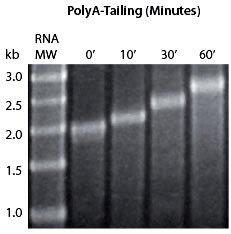Poly(A) Polymerase Tailing Kit
Product Details
ShowContents: Poly(A) Polymerase, 10X Reaction Buffer, 10 mM ATP, Sterile RNase-Free Water.
Poly(A) Polymerase Tailing Kit
Key features
Show- Polyadenylate 3' ends of RNA molecules for various downstream applications
- Quality Kit: High enzymatic purity, specificity, and activity
- Flexible: Use polyadenylated RNAs in a variety of applications such as stabilising in vitro transcribed RNA and adding primer (oligo-dT) binding sites to any RNA for first-strand cDNA synthesis
- Fast and Easy: Simple protocol produces polyadenylated RNA molecules quickly
Size: 50 reactions
Product information
Unit Definition: One unit of Poly(A) Polymerase catalyses the incorporation of 1 nmol of AMP into acid-insoluble form in 10 minutes at 37 °C under standard assay conditions.
Storage Buffer: 50% glycerol containing 50 mM Tris-HCl (pH 7.5), 100 mM NaCl, 1 mM DTT, 0.1 mM EDTA, and 0.1% Triton® X-100.
10X Reaction Buffer: 0.5 M Tris-HCl (pH 8.0), 2.5 M NaCl, and 100 mM MgCl2. A separate 10-mM ATP Solution is also provided.
Quality Control: Poly(A) Polymerase is tested for polyadenylation of RNA in vitro. It is free of detectable exo- and endonuclease and RNase activity.
SDS
Manuals and user guides
Product information sheets
Access support
Need some support with placing an order, setting up an account, or finding the right protocol?
Contact us